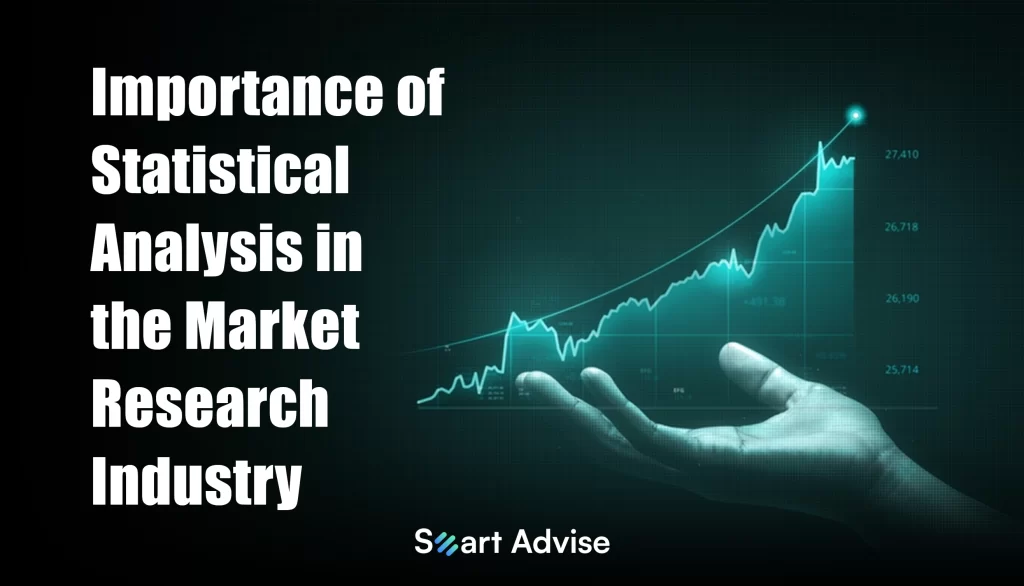
The bifurcation of extensive data into the easily accessible and intelligible data is what statistical does, know more how it can help your business to grow
Market research helps businesses and organizations make good choices in a world that is becoming more and more data-driven. But getting data isn’t enough on its own; examining it is what really shows what it can do. Statistical analysis is a key part of market research, and it helps businesses get useful insights, make accurate predictions, and stay ahead of the competition in a competitive market. In this blog, we’ll talk about how important statistical analysis is in the market research business. To show how important it is.
1. Understanding Customer Behavior
Statistical analysis plays a pivotal role in understanding customer behavior. Businesses can learn more about their customers’ tastes, shopping patterns, and industry trends by evaluating data gathered from a variety of sources. This information is invaluable for product development, marketing strategies, and customer relationship management.
For instance, e-commerce giants like Amazon and Alibaba use statistical analysis extensively to recommend products to users based on their past purchases and browsing history. The result is a happier clientele and more purchases.
2. Market Segmentation
Market research involves categorizing customers into different segments based on various factors like demographics, psychographics, and behavior. Statistical analysis helps in identifying these segments accurately and efficiently.
This segmentation allows businesses to manage their marketing efforts to specific groups, resulting in higher engagement and conversion rates. For example, a cosmetics company can use statistical analysis to identify segments of customers who prefer organic products and then create targeted marketing campaigns for this group.
3. Predictive Modeling
Predictive modeling is another crucial aspect of market research. Statistical analysis allows businesses to build predictive models that forecast future trends and outcomes based on previous data.
In a study by Grand View Research, A 23.2% CAGR is projected for the global predictive analytics industry, which was worth $5.7 billion in 2018.
These predictive models can be applied in various ways, such as predicting sales figures, customer churn rates, or demand for a particular product. This enables companies to make proactive decisions and allocate resources efficiently.
4. Competitive Analysis
To stay competitive, businesses need to keep a close eye on their competitors. Statistical analysis helps in comparing a company’s performance with that of its rivals.
For instance, if a retail chain sees that its competitors are gaining market share in a particular region, they can use statistical analysis to determine the underlying factors and develop counterstrategies.
5. Risk Assessment
Market research is not just about seizing opportunities; it’s also about managing risks. Statistical analysis can identify potential risks and assess their impact on a business.
A report by Markets and Markets says, at a CAGR of 12.4% between 2022 and 2027, the worldwide risk analytics market is expected to expand from $39,3 billion in 2022 to $70,5 billion.
For example, financial institutions use statistical analysis to evaluate credit risk. Approval for a loan can be determined after careful consideration of the applicant’s credit score, income, and payment history.
6. Product Development
To survive in today’s market, innovation is mandatory. Statistical analysis aids in product development by analyzing customer feedback, market trends, and historical data.
Companies like Apple use statistical analysis to gather customer feedback on their products. They then use this data to make iterative improvements, leading to better products that meet customers’ needs more effectively.
7. Marketing Effectiveness
Marketing is a significant expense for most businesses, so it’s crucial to assess its effectiveness. Statistical analysis provides the tools to measure the ROI of marketing campaigns.
A report by Deloitte’s CMO Survey states that companies spend, on average, 8.9% of their budgets on marketing analytics.
For instance, digital marketing campaigns can be analyzed using statistical techniques to determine which channels and strategies are delivering the best results and so planning the adequate budgeting and this process is also called Attribution Modelling. This data-driven approach helps companies optimize their marketing spend and achieve higher returns.
8. Trend Identification
Trends in consumer behavior, technology, and the business environment are constantly evolving. Statistical analysis is essential for identifying these trends early and adapting strategies accordingly.
Companies can seize opportunities and avoid pitfalls by staying ahead of the curve. For example, the rise of e-commerce was identified as a significant trend well before it became mainstream, allowing early adopters to gain a competitive advantage.
In Summary,
Statistical analysis is the backbone of the market research industry. It empowers businesses to understand customer behavior, segment markets, make predictions, study competition, assess risks, develop products, measure marketing effectiveness, and identify trends. In a data-driven world, the ability to harness and interpret data is a key driver of success.
As shown by data, the use of statistical analysis in market research continues to grow. Businesses that use statistical analysis gain a significant competitive edge by making informed decisions that lead to increased efficiency, improved customer satisfaction, and higher profitability. Stay ahead of the market and access the most precise data by partnering with us.